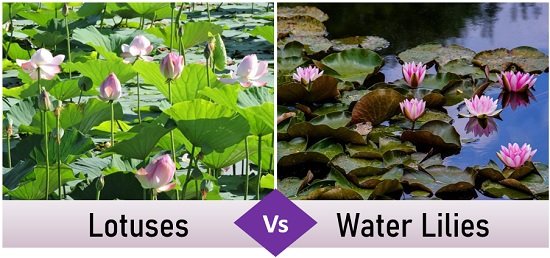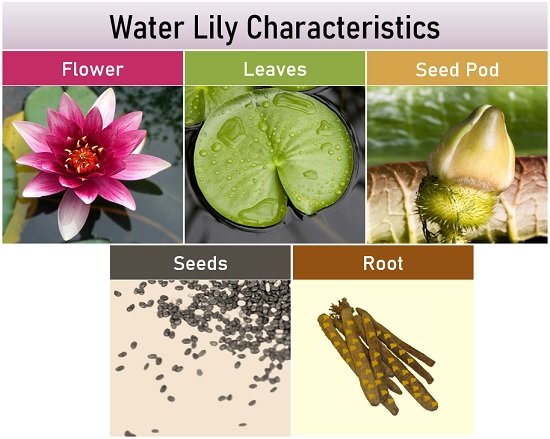Water lily and lotus are aquatic flowering plants. At first glance, you may get confused between the two, but these beautiful flowers have notable differences. First, they belong to different families of flowering plants and have different growth patterns.
Water lilies (Nymphaea species) belong to the Nymphaeaceae family. In contrast, lotuses (Nelumbo species) belong to the Nelumbonaceae family.
Flowers and leaves of most water lilies grow on the water’s surface. On the contrary, the leaves and flowers of the lotuses grow above the water.
They both add vigorous beauty and variety to places where they grow, like ponds or lakes. Besides, water lilies and lotuses are the jewels of ponds as they maintain the well-being of ponds.

They are not only pleasing to the eye but also provide shelter to aquatic creatures from sunlight exposure and predators lurking nearby. Secondly, these flowers maintain the temperature of water bodies during the hot summers.
Third, they absorb water minerals and block most of the sunlight resulting in reduced or no growth of algal biomass. Thus, these flowers keep the water clean and clear looking.
This post enlightens you with the key differences between the water lily and lotus with a comparison chart. You will learn the morphological and growth characteristics of the water lily and lotus flowers.
Content: Water Lily Vs Lotus
- Comparison Chart
- Water Lily Characteristics
- Lotus Characteristics
- Key Differences
- Similarities
- Conclusion
Comparison Chart
| Properties | Water Lily | Lotus |
|---|---|---|
| Family | Nymphaeaceae | Nelumbonaceae |
| Genus | Nymphaea | Nelumbo |
| Types | Tropical and hardy water lilies are the two major groups | Nelumbo nucifera and Nelumbo nutea are the two known-species |
| Natural growth | Shallow water (nearly 2-5 feet deep) | Deeper water (about 12 feet deep) |
| Height | Grow comparatively smaller (8 inches tall) | Grow bigger in size, generally 6 feet tall |
| Growth | Hardy types float on the surface, and tropical types are slightly above the water surface | Lotuses grow above the water surface |
Flowers |
||
| Size | Both smaller and larger varieties exist | Generally larger than the water lily flowers |
| Petals | They appear pointed or shaped like stars | lotus petals appear more rounded, or sometimes ruffly |
| Colour | Exist in various range of colours | The colour range is limited in comparison to water lilies |
| Fragrance | Strong or more defined during blooming | Subtle or less defined |
| Carpels | Three to more connate or distinct carpels | A carpellary receptacle has a flat-topped, usually yellow cone-like structure that holds the ovaries or carpels |
| Stamens | They are laminar to filamentous types and are found many in number | They are numerous, appear thin, filamentous and surround the carpellary receptacle |
| Life span after pollination | Lily flowers last longer, up to two weeks | Lotus flowers wither within 2-3 days |
Leaves |
||
| Appearance | Thick and waxy | Thin and papery |
| Shape | Round with a noticeable notch in each leaf | Fully round with no slit |
| Outer surface | Waxy cuticle | Trichomes |
| Surface wetting | Leaves can hold water due to the waxy coating on the leaves | Lotus leaves do not get wet as water rolls off the leaf surface |
| Variegation | Tropical lilies have variegated leaf foliage | Leaves have a consistent green colour |
Seeds |
||
| Ripening | It takes place underwater | It takes place above the water surface |
| Seed pod | Release seeds underwater | Releases seeds on the water surface |
| Cultivation | They can be cultivated from seeds, tubers or leaves | They can be grown from rhizomes or seeds only |
Water Lily Characteristics
Water lilies are perennial aquatic plants, having round leaves with a distinct slit and starry flowers floating placidly on the water surface. They grow in freshwater lakes, ponds, streams and ditches.
Classification
- Kingdom: Plantae
- Clade: Tracheophytes
- Clade: Angiosperms
- Order: Nymphaeales
- Family: Nymphaeaceae
- Genus: Nymphaea
Rhizome
It is a modified stem that appears tubular, bulb-like and grows horizontally underwater within the mud. Rhizome gives off many root stalks that hold the flowers and leaves.
Rhizomes are fleshy tubers that store nutrients and support plant growth. Stalks from the rhizome are comparatively smaller than the lotuses.
Leaves
The long petioles from the rhizome support the water lily leaves. Leaves appear round and waxy and have a visible slit on one end. Floating leaves of water lilies can reach up to 6 feet and are called lily pads.
Some leaves are underwater, and few float over the water surface. The size of leaves varies depending upon the species but typically ranges between 12 to 20 inches in diameter.
Flower
Each stalk holds a single flower that looks like a star. Flowers of hardy water lilies generally float on the water. But tropical water lilies can grow 8 inches above the water.
In the centre, they have distinct pistils and stamens. Flowers grow in a rainbow of colours, including red, pink, yellow and many more colours.
The majority of flowers are smaller than the lotuses. Although, Victoria amazonica is one of the species with gigantic flowers as lotuses.

Seeds
Water lily flowers bloom for an average of 3-4 days after pollination. Once flowers are pollinated, they fall into the water. There, seed pods develop and mature. On maturation, the seed pods swell and appear slightly bend from the stalk.
So, the seed ripening occurs under the water. There, the pod opens and releases many seeds under water. Among them, only mature seeds germinate into new plants.
Lotus Characteristics
Lotuses are perennial, aquatic plants having fully round leaves and starry flowers floating above the water surface. Lotuses grow in a range of shallow wetland habitats (lakes, ponds etc.). Lotus is the national flower of India.
Classification
- Kingdom: Plantae
- Clade: Tracheophytes
- Clade: Angiosperms
- Order: Proteales
- Family: Nelumbonaceae
- Genus: Nelumbo
Rhizome
The lotus rhizomes are buried deep inside the mud of still water. They are edible, and you can eat them in a raw or pickled form. A rhizome is a creeping rootstalk that appears oblong or tubular.
It grows inside the mud and forms large, thick and fleshy stalks that hold leaves and flowers. Lotuses propagate mainly through rhizome division.
Leaves
Lotuses’ leaves are typically round, thin and non-shiny. The leaf surface does not get wet if you sprinkle water. Unlike water lilies, there is no slit on the leaf margin on the lotus’s leaves.
You could also notice a depression towards the centre of the leaf. Most leaves are emergent or above the water surface, while a few are submerged and floating. The size or diameter of lotus leaves exceeds 30 inches.
Flowers
As the lotus blooms, the blossoms unfold petal by petal. Lotuses have large, broad, round-to-oval petals with a papery appearance.
They grow nearly 4-6 feet above the water surface, generally in ponds. But, in small ones, they can reach up to 2-4 feet above the water.
In the centre, an androecial ring is present around the cone-like carpellary receptacle. The overall size of the lotus flower is larger than the water lilies.
Some flowers reach a height of 2 feet. The petals last for a handful of days after pollination.

Seeds
Lotus flowers bloom for an average of 3-4 days after pollination. Once pollination occurs, the petals wither, and only the seed pod remains on the stem. The seed pod ripens or matures over time.
After ripening, the seed pod bends down and pops out to release seeds over the water surface. Later, seed dispersal occurs by animals or the flow of water. Thus, fertile seeds will germinate into a new plant.
Key Differences Between Water lily and Lotus
- Water lily or Nymphaea is a genus having 70 species with two varieties (hardy and tropical). Lotus or Nelumbo is the genus having only two species, Nelumbo nucifera (sacred lotus) and Nelumbo lutea (American lotus). Thus, the species diversity of water lilies is much broader than the lotuses.
- The lotus requires 12 inches of water to grow, while water lilies grow in water with a depth of 2 to 5 feet.
- Petals of water lilies appear pointed or shaped like stars. Lotus petals appear rounded or sometimes irregular.
- The central region of these two flowers is distinct. Water lilies comprise many laminar to filamentous type stamens and three to more connate or separate carpels. Lotuses have numerous filamentous stamens surrounding the cone-like carpellary receptacle (which holds ovaries).
- Water lily leaves appear round, thick and waxy, with a notable slit on one end. In contrast, lotus leaves appear fully rounded, thin and papery.
- Surface wetting is one of the interesting features in which we could check the water holding capacity of the leaves. Water lily leaves can retain water on their surface due to the outer waxy cuticle. Lotus leaves do not get wet; water beads into spheres and rolls down the leaf.
- Tropical lilies have variegated leaf foliage tinged with a dark purple colour or completely purple at times. On the contrary, lotus leaves are consistently green.
- Cultivation of water lilies is possible through seeds, tubers or leaves. Oppositely, cultivation of lotuses is possible through rhizomes or seeds only.
Similarities
- Both water lilies and lotuses are stunning flowering plants that are aquatic.
- Both flowers have a wide range of colours, depending upon the species’ variability.
- Lotuses and water lilies require direct sun exposure for up to six or more hours.
- Water lilies and lotuses are invasive flowering plants that grow very fast.
- Both flowers are symbolic of good things like beauty and wealth.
- Seeds of water lilies and lotuses are highly nutritious, and you can consume them as healthy snacks.
Conclusion
Water lilies and lotuses grow in still or slow-moving water habitats. These flowers share a rich colour palette that is beautiful to look at. But, they share many distinct features opposite to each other that we discussed above.